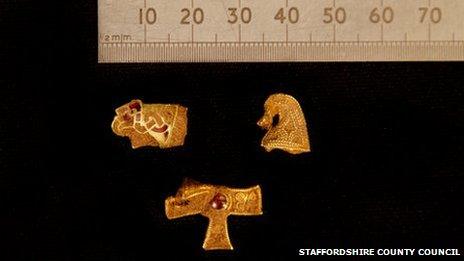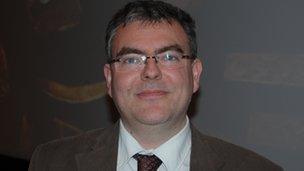Staffordshire Hoard: 'Shedding light on the Dark Ages'
- Published

Some of the gold and silver artefacts weigh less than a gram, archaeologists said
"The period is traditionally called the Dark Ages because we don't know enough about it, but finds like this can definitely shed some light on that period," says archaeologist Steve Dean.
He works for Staffordshire County Council and was part of a team that uncovered 90 new items of gold and silver believed to be part of the Staffordshire Hoard.
The group of archaeologists and metal detector enthusiasts discovered the items in the field at Hammerwich where 3,500 pieces of Anglo-Saxon gold were found in 2009.
"It echoes what we have previously. The items seem to be very similar in style, form, shape and design as the previous hoard so it will add texture to what we already have," said Mr Dean.
The pieces include a possible helmet cheek piece, a cross-shaped mount, an eagle mount and some fragments that fit with parts of the original hoard.
'Significant find'
Mr Dean said: "If you look at this cheek piece then we've potentially got a set now - we've got a pair.
"We're looking at how they were made and manufactured but we're also looking at elements of how a helmet was created.
"Was it functional? It's a lot more than just the value of gold and silver - it's art, it's design.
"We're also finding out about their attitudes to battle."
The pieces are currently being examined and X-rayed at a laboratory and Mr Dean said they wouldn't be cleaned up for some time.
"By being covered in muck and grime the pieces are still protected, but there may also be important information contained in the soil itself, so we are loath to clean anything that's part of the process."
David Symons from Birmingham Museum and Art Gallery said the new find was "significant."
"We tend to forget, we are so blown away with having this whole hoard, that five years ago the discovery of just one piece of what was found would've been a major discovery for this part of the world.
"We do need to be careful about saying it's definitely part of the hoard yet, because that's a legal decision for the coroner to make, but it does seem an important find," he said.
'More manageable'
South Staffordshire Coroner Andrew Haigh will rule at an inquest on 4 January whether the pieces should be declared treasure and are actually part of the Staffordshire Hoard.

Steve Dean was part of the team that discovered the 90 items of gold and silver
If he rules that it is part of the collection, the British Museum will value the items and local museums will be able to acquire them.
Stoke-on-Trent City Council and Birmingham Museum and Art Gallery jointly own the original hoard, which includes 3,900 artefacts and was valued at £3.3m.
They acquired the hoard after a 12-week fundraising campaign, in which £900,000 was raised through public donations, with funding from the National Heritage Memorial Fund and five local councils.
The leader of Staffordshire County Council, Philip Atkins, said he was hopeful the money could be raised to keep the new pieces in the West Midlands.
"Fundraising wasn't easy last time but it should be more manageable this time around because we've only got 90 pieces not 3,000-odd," he said.
"I'm pretty certain local people will step up to the plate and help us raise the money, even in these hard times."
- Published18 December 2012
- Published21 July 2012
- Published17 May 2012
- Published26 January 2012
- Published29 October 2011
- Published3 July 2011
- Published16 April 2011